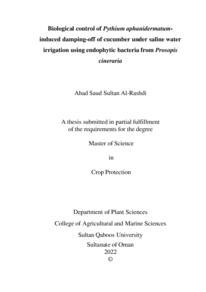Document
Biological control of Pythium aphanidermatum induced damping-off of cucumber under saline water irrigation using endophytic bacteria from Prosopis cineraria.
Other titles
المكافحة الحيوية لمرض موت البادرات في الخيار بإستخدام البكتيريا الجذرية المستخرجة من شجرة الغاف تحت ظروف ملوحة مختلفة
Publisher
Sultan Qaboos University.
Gregorian
2022
Language
English
English abstract
Cucumber is an important vegetable crop in Oman. Soil salinity and
damping-off disease incited by Pythium aphanidermatum are the major concerns in
the production of cucumber in Oman. In this study, the biocontrol efficacy of
endophytic and rhizosphere bacteria from Prosopis cineraria, a halophyte, was
evaluated against damping-off of cucumber under different salt-water irrigation (50,
100, 150 and 200 mM NaCl) conditions. A total of 6 endophytes and 8 rhizobacteria
differing in their morphology were isolated from the roots and rhizosphere soils of P.
cineraria, respectively on nutrient agar medium containing 2.5% NaCl. Among
them, 4 endophytic bacterial isolates, designated as PC1, PC3, PC5 and PC6
inhibited P. aphanidermatum growth in a dual-culture assay. The isolate PC5 showed
the highest mycelial growth inhibition (42.9%), followed by PC6 (34.8%), PC1
(24.3%) and PC3 (23.8%). These isolates were identified as Pseudomonas putida
(PC1), Acinetobacter johnsonii (PC3), Pseudomonas aeruginosa (PC5) and
Pseudomonas mosselii (PC6) based on maximum-likelihood analyses of 16S rDNA
sequence data. These bacterial strains were compatible among them and capable of
forming biofilm. P. aeruginosa PC5 produced volatile compounds that inhibited P.
aphanidermatum growth by 57.3% in an in vitro assay. Analysis of the volatile
compounds (VOCs) of P. aeruginosa PC5 revealed the presence of dimethyl
disulfide as a major component (46.2%) followed by lactic acid (21.3%). Greenhouse
test results revealed that soil application of these bacterial strains had no significant
effect on damping-off incidence under non-saline irrigation. However, under saline
water (50 mM NaCl) irrigation A. johnsonii PC3 showed the highest biocontrol
efficacy with 82 % reduction in the disease incidence, with no significant effects at
concentrations of 100 mM NaCl and above.
The effect of NaCl on bacterial growth and VOCs production was
determined. NaCl had inhibitory effects on the growth of both P. aeruginosa PC5
and A. johnsonii PC3 at the tested concentration of 7.5% and above. NaCl at 5%
slightly stimulated the growth of both the bacterial strains and higher growth rate was
observed at 72 h compared to 0% NaCl. Headspace solid-phase microextraction,
followed by gas chromatography-mass spectrometry analysis of the VOCs produced
by these endophytes revealed that dimethyl disulfide (DMDS), a well-known
antimicrobial compound, was the major compound released by P. aeruginosa PC5 in
the absence of NaCl, whereas the production of DMDS was completely inhibited
when it was cultured in a medium containing high concentrations of NaCl.
Trimethylsilanol followed by l-alanine ethylamide, (S)- were released abundantly by
A. johnsonii PC3 when grown in the salt-amended medium compared to control,
suggesting possible involvement of these compounds in the suppression of P.
aphanidermatum by this bacterium under salt-stress conditions.
Member of
Resource URL
Arabic abstract
يعتبرالخيار )L sativus Cucumis )من المحاصيل المهمة المزروعة في سلطنة عمان. وتعتبرملوحة التربة ومرض موت البادرات الناتج عن الفطر )aphanidermatum Pythium )من المعوقات الرئيسية لزراعة الخيار في عمان. الهدف العام من هذا البحث هو عزل البكتيريا النابتة الداخلة و البكتريا الجذرية من شجر الغاف (Prosopis cineraria)
Category
Theses and Dissertations

